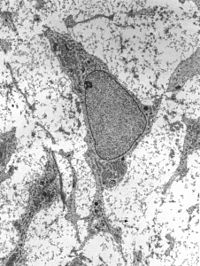
Photo from wikipedia
Background As a regulator essential for many cell cycle-related proteins, the robust expression of Cell cycle-Related and Expression-elevated Protein in Tumor (CREPT) implicates a poor diagnosis of endoderm and mesoderm-derived… Click to show full abstract
Background As a regulator essential for many cell cycle-related proteins, the robust expression of Cell cycle-Related and Expression-elevated Protein in Tumor (CREPT) implicates a poor diagnosis of endoderm and mesoderm-derived tumors. Whether CREPT plays the same role in the tumorigenesis derived from ectodermal tissues remains elusive. Methods To explore the role of CREPT in ectoderm-derived tumors, cells from 7oral squamous cell carcinoma (OSCC) lines and 84clinical OSCC samples were exploited in this study. Quantitative PCR, Western blot assay and immunohistochemistry were applied in the evaluation of CREPT, cyclin D1 and c-Myc expression. Knocking-down of CREPT was performed by lentivirus delivering specific shRNA of CREPT. The effects of CREPT on OSCC were examined by cell proliferation, colony formation, apoptosis, cell migration and xenograft implantation experiments. Results Compared with human normal oral keratinocytes, OSCC cell lines showed a significantly elevated expression of CREPT in both mRNA and protein levels. Consistently, samples from OSCC patients also exhibited a noticeably stronger CREPT expression than the noncancerous samples. In contrast, knocking down of CREPT in OSCC cell lines significantly reduced proliferation, colony formation and migration as well as the expression of cyclin D1 and c-Myc, but promoted apoptosis. Statistical analysis also suggested that CREPT expression was significantly correlated with the T and N classification of OSCC. Furthermore, CAL27 mouse xenograft model confirmed that down-regulation of CREPT prohibited cyclin D1 and c-Myc expression, through which decreased the in vivo tumor growth, but increased the survival ratio of hosts. Conclusion In OSCC cell lines, up-regulated CREPT expression enhanced cell proliferation, migration and cell cycle as well as promoted cyclin D1 and c-Myc expression as it did in endoderm and mesoderm-origin tumors. Our study strongly suggests that CREPT could be used as a marker for the OSCC prognosis and might work as a potential target in future OSCC therapy.
Journal Title: PLoS ONE
Year Published: 2017
Link to full text (if available)
Share on Social Media: Sign Up to like & get
recommendations!